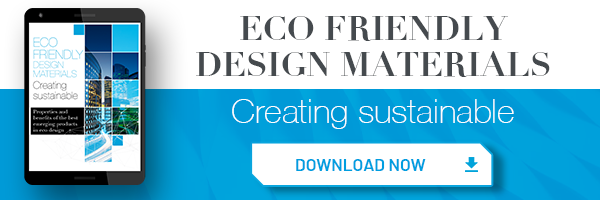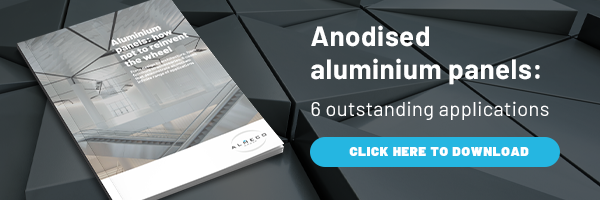Visit any major city and invariably, you will come across an office or apartment block that is clad in metal. For decades, designers have embraced metal cladding for its flexibility and finish. Its popularity is mainly due to its incredible versatility, both avant-garde and off-the-shelf.
Anodised aluminium façade cladding is particularly desirable for both enveloping a façade or roof and there are several distinct reasons why the material is preferable to steel.
Anodised aluminium’s light weight has many key benefits
An overriding reason for anodised aluminium’s preference for cladding buildings as opposed to steel is that it is considerably lighter. Its light weight has several key advantages. The most striking of these is that shipping and transporting costs to a job site or manufacturing facility are greatly reduced, which has a knock-on effect of being more sustainable. Due to aluminium’s lightness, less trips need to be made as greater loads can be transported at any one time.
Anodised aluminium’s lightness also means that the material is easier to work with and mount onto a building façade.Given that anodised aluminium possesses an excellent strength-to-weight ratio, this results in several benefits. Among them, one of the main advantages is that aluminium façade attachment systems can be less bulky than those needed for steel panels. A reduction in a supporting structure for the anodised aluminium panels also reduces overall costs. Whereas, to clad a façade in steel requires greater investment. Given that steel is a heavier material, it requires a stronger support structure to hold the steel panels in place adding to the costs.
What is cladding?
Cladding refers to the application of one material over another to provide a protective skin or layer. In the context of building construction, cladding serves multiple purposes, including protecting the building from adverse weather conditions, enhancing its aesthetic appeal, and providing thermal insulation.
Typically, cladding materials include metals such as aluminium and steel, as well as wood, plastic, stone, and composite materials. The choice of cladding material can significantly impact the building’s appearance, energy efficiency, and maintenance needs.
Therefore, the process of selecting and implementing cladding is a critical aspect of construction, requiring careful consideration of material properties, environmental impact, and architectural objectives.
Anodised aluminium, with its lightweight and strength, offers a modern and durable option for building façades, contributing to both the functional and visual aspects of architectural design.
The aesthetics of aluminium in façade cladding
An anodised aluminium façade cladding is a sight to behold. Many building facades will be clad with anodised aluminium panels of a metallic appearance that constantly interacts with the changing natural light. But like steel, anodised aluminium can also be coloured with different nuances and different visual effects can be achieved, such as perforating the material or 3D textures. The process used to achieve these aesthetic finishes is often different. Colouring steel is usually done using a more traditional batch process or by paintings. Whereas raw anodised aluminium is pulled through a series of tanks that clean, anodise, colour, and seal the material in one continuous movement. This process is more controlled, and results in greater colour consistency and surface homogeneity.
What are the benefits of aluminium facade cladding?
Aluminium façade cladding stands out as a superior choice for both modern and traditional buildings, owing to its remarkable blend of aesthetic appeal, durability, and environmental sustainability.
This material brings several advantages to the architectural domain, such as:
- It’s easy to install. Its lightweight nature ensures an ease of installation and reduces the structural load on buildings, making it a cost-effective solution for large-scale projects
- It’s a very durable and strong material. Aluminium’s inherent anti-corrosive properties and the ability to withstand harsh weather conditions without deteriorating over time guarantee a long-lasting and visually appealing façade
- It’s a sustainable material. With its recyclability and energy-efficient production, aluminium aligns with the growing demand for green building practices, while its flexibility and malleability allow for innovative designs and shapes.
All these characteristics, that we’ll analyse in more detail shortly, make aluminium a versatile choice for architects and builders aiming to achieve both aesthetic excellence and environmental sustainability in their projects.
Anti-corrosive qualities
Aluminium façade cladding is preferred over steel as it has excellent corrosion resistance. Even in its natural state, aluminium does not corrode in the same way as iron or steel. Its natural oxide layer resists corrosion. When aluminium is anodised, it will never rust or weather, which makes it an attractive choice for cladding buildings. There is also no risk of fading or chalking.
Aluminium can be recycled again and again
One of the key advantages of aluminium over steel is that it can be recycled repeatedly through simple re-melting with minimal loss on each cycle. In Europe, more than 30% of aluminium consumption uses recycled aluminium and over 90% of the aluminium used in buildings is recycled at the end of a building’s life. The recycling process requires only 5% of the energy needed to produce primary aluminium. This is a significant contribution to environmental sustainability.
All these factors add up to make aluminium a preferable material than steel and is ideally placed for cladding building façade and roofs. Aluminium is a highly versatile and durable material that is also extremely malleable. Due to its great flexibility, aluminium can clad difficult junctions or when used in standing seam applications, can be rolled out to clad a whole roof, such as a stadium.
Which types of aluminium façade cladding do we produce?
Almeco offers the wider range on the market of preanodised coloured and/or pattern surfaces for cladding application. In particular, bandoxalpro is the product specifically optimised for cladding applications in façades.
This line of preanodised surfaces for architecture is in fact designed to meet the specific requirements of each architectural project, with products designed to offer an aluminium layer between 0.5 mm and 3 mm thick.
Bxprobond, specifically, is ideal for being combined with other materials thanks to its low thickness (0,5mm). In bandoxalpro the anodic layer is modified for the hot gluing process by aluminium composite panel manufacturers, and it is therefore suitable to produce composite panels.
A line of surfaces that offer a wide choice in terms of colours and finishes, with the possibility of creating unique designs that blend in with their surrounding environment (as in the case of mirrored façades) or stand out with distinctive shapes and colours, as in the case of 3D surfaces.
In addition, Almeco’s surfaces for façade cladding can be customised for specific application’s needs thanks to our team of consultants which assist our customers in every step of the project.


